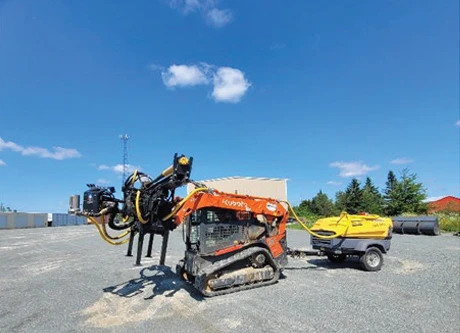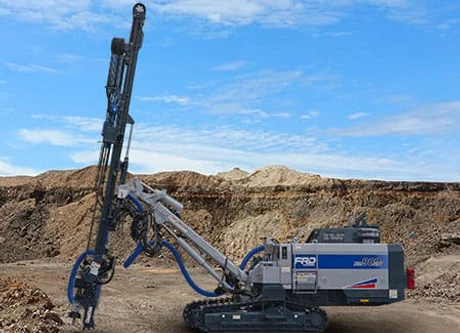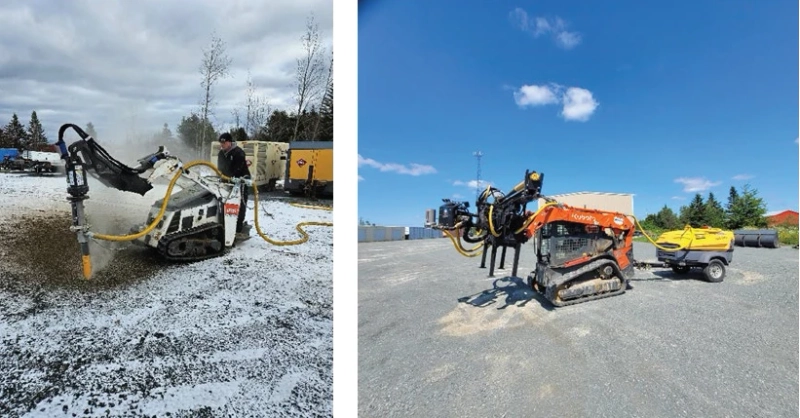Hard rock drilling projects are known to demand specialized tools and applications that can tackle the strong and dense materials in the rock. Rocks typically have multiple materials inside them, starting from granite, basalt, and quartzite. The usage of the wrong tools means that equipment might get damaged, and the progress of clearing out the rocks can be stalled indefinitely.

In this guide, we are going to discuss the best machinery and techniques that are required for drilling through geological formations. Ultimately, this guide will deal with the processes that help retain top productivity and precision for the rock drilling process.
1. Rotary Hammer Drills for Precision and Power
Ideal for Controlled Penetration
Rotary hammer drills are ideal for combining the rotation and percussive force, which makes them capable of drilling rock with hammer drill. These tools are also chosen as they can create clean, deep holes in hard rock while minimizing the vibration of the system. Look for those models with adjustable speed settings and SDS-plus or SDS-max chucks that are ideal for enhanced bit stability.
Common applications of the system are as follows:
- Anchor the bolts in rock faces
- Installing utilities in Bedrock
- Sampling for geological surveys
If you are into the drilling business, it is best to pair the system with carbide-tipped drill bits to extend the life of the tools and reduce wear and tear.
2. Hydraulic Rock Breakers for Heavy Duty Demolition Needs
Hydraulic breakers are often mounted over the excavators to deliver high-impact for fracturing the toughest of the rocks. Therefore, with such heavy rock breaking tools, which are indispensable for large-scale projects, you can easily use them for purposes like quarrying and tunneling.
This is important as in such cases of dense rocks, the manual processes are not feasible, or they can be extremely problematic.
Some of the features of the rock breaking tools are as follows:
- Adjustable impact frequency that generates beats of up to 600 BPM or, in some cases, 1800 BPM
- Compatible with various types of carrier machines that might be there in the excavation area
- Minimal dust generation compared to heavy explosive usage for fracturing the rocks
Ultimately, if you are looking for hard rock drilling, using hydraulic breakers seems to be one of the best ways to do such operations. Please NOTE that operators must wear vibration-dampening gears and ear protection to secure themselves against such a force.

3. Diamond Core Drills for Cutting Accuracy
Used for Precision in Sampling and Construction
Diamond core drills are known to use industrial-grade diamonds, which are embedded inside the bit to cut through the rock. Moreover, this method is also known to provide cylindrical core samples and minimal material loss during drilling. This is an effective step or consideration for engineering construction or mineral exploration.
Some of the advantages it has over conventional drills are:
- Reduced heat generation in the drill-bit that might degrade the tips
- Ability to drill large diameters which is up to 6 inches
- This is suitable for both wet and dry drilling cases
A tip for proper usage of the system is that one must always use the water-cooled attachment for its operations and extend the life of the drilling machine.
4. Portable Pneumatic Self-Adjusting Drills
Pneumatic self-adjusting drills are lighter than hydraulic breakers, which makes them ideal for smaller projects. While less powerful, they are handy for shattering boulders or trenches through quite hard rock.
Major Considerations for Rock Drilling Efficiency
Material Hardness and Tool Selection
Test rock hardness on the Mohs scale:
- 6–7 (Basalt, Granite): Hydraulic breakers or diamond drilling.
- 8+ (Quartzite): Special carbide or diamond-tipped tools.
Maintenance procedures
- Lubricate drill bits and breaker seals to avoid overheating.
- It is recommended to replace the drill bits or sharpen them to save energy
- Safety procedures
- Perform ground stability tests to avoid collapses.
Conclusion
Equipment selection is the key to efficient hard rock drilling operations. From precise rotary hammer drills to hydraulic breakers for extensive demolition, each of these has its role in the success of overcoming geologic obstacles.
With top-of-the-line rock-breaking gear and adherence to safety best practices, productivity can be realized to a peak while the risk is minimal.
With a concrete demolition machine or dedicated diamond core rigs, investment in heavy-duty, purpose-built equipment keeps your operation on the go, no matter the unfriendly weather.


